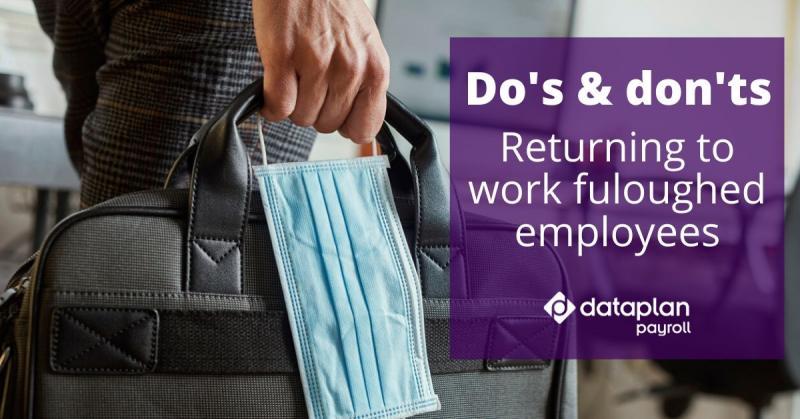
The Coronavirus Job Retention Scheme has now been extended until the end of October with any claims after the 1st July only accessible for employees already on the scheme.
Although the deadline for putting an employee on furlough for the first time was the 10th June, there is an exception to this. Employees returning to work from maternity, paternity leave, adoption, shared parental and parental bereavement leave can still be furloughed as they have been away from work for an extended period of time.
Flexible furlough – the next phase
Flexible furlough is being introduced from July and I believe this is key to the transition from furlough to work when you bear in mind how long many employees have been out of the working environment.
Government advice is still that people should work at home where this is possible. If you, as an employer need your employees back in the workplace you should first look at who you need in and plan around a minimum number of employees in order to work effectively and most importantly safely.
It would be good practice to give employees as much notice as possible of the end of their furlough as many will have caring arrangements/responsibilities and will need time to put alternative plans in place.
As an employer you should be protecting employees who are at in the higher risk category, these employees will have been advised to shield and not to carry out work outside their home. Those who are at moderate risk (those who are aged 70 and over, pregnant or with certain health conditions) should work from home where possible and if this is not practicable they should be offered the safest roles within your business where social distancing is possible.
New ways of working to support social distancing
COVID-19 Secure guidelines, set out by the Government state that alternating start/finish times and shifts are one of the steps an employer could and probably should take to ensure social distancing. This I believe will increase employee’s confidence that the work place is as safe as it can be and also relieve congestion on the public transport network. Another way of ensuring social distancing could be that you alternate your employees/teams/groups so that they attend the workplace on different days in order again, to assist with social distancing requirements.
Don’t fall foul of Employment Law
Be aware that in order for an Employer to not fall foul of Employment Laws you should seek agreement with your employees to change working time/days etc. even if it’s on a temporary basis as you are changing their terms and conditions of employment. Talk to your employees and remember to take into account their individual circumstances as many employees will still have children that have not returned to School and other caring commitments that changing their days and hours could affect.
Being consistent is key and will help you as an employer avoid setting precedents which may become unmanageable in the future. Employees need to be informed that any measures put in place (i.e. change of working hours) are temporary and cannot be maintained indefinitely.
Reassure your employees
Employee safety is paramount during this initial returning to the workplace and you will have nervous employees who will require reassurance that they are not being put at increased risk by returning to work. Requiring an employee to return to work to an unsafe environment could breach your employer duty of care under Health and Safety Laws.
You will undoubtedly, however, have employees who are worried and fearful that returning to the workplace will put them at an increased risk of contracting COVID 19. Here I would advocate communication as being key.
Speak to your employees and share with them all the measures that you as a business are taking to ensure that the working environment is as safe as you can possibly make it. By communicating with your employees and demonstrating what you are doing in order to keep them safe will help show that you are prioritising your employee’s health and wellbeing.
As an employer I would advise that you take the specific circumstances of an anxious employee into consideration as this is going to be relevant in your decision making. For example, an employee may fall into the high risk category, or their partner may have been advised by the NHS to shield for 12 weeks because they are in the extremely high risk category. If an employee in this position still does not want to return to work, you as their employer can agree a new or extended period of homeworking, or arrange for them to take time off as holiday or unpaid leave.
If an employee refuses to attend work without a valid reason, you may wish to consider disciplinary action, although I would advise caution and seek advice on the specific situation before you take any action.
BUT, remember, people are human beings and, as individuals all have their own worries and concerns that you as an employer can help alleviate. The little things can have a big impact, a simple phone call “how are you” could make all the difference to an anxious employee.
In summary:
- Give employees as much notice as possible of a return to the workplace
- Plan around the minimum number of employees you need in the workplace
- Protect those employees in higher risk categories by keeping WFH or placing in low contact scenarios
- Look at implementing alternative start/finish times and shifts (especially to avoid peak travel times)
- Bring in teams on staggered days if possible
- Don’t forget that you must seek agreement from employees to make any changes to working patterns
- Take into consideration the personal circumstances of each employee
- Communicate, communicate, communicate
Nikki Whitaker
Commercial HR Business Partner
Dataplan are one of the UK’s leading providers of specialist payroll and associated services.
From payroll outsourcing and pension service management to ePayslips and gender pay gap reporting; we have a solution for you and your business.
